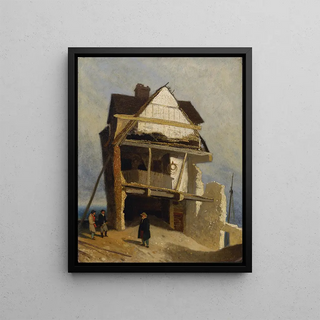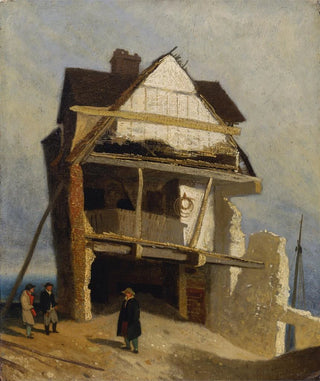Art print | Ruined house - John Sell Cotman


View from behind

Frame (optional)
Maison en ruine - John Sell Cotman – Captivating Introduction
The ephemeral nature of architecture and the inexorable passage of time are recurring themes in the work of John Sell Cotman, a master of 19th-century British landscape painting. In his renowned artwork "Maison en ruine," Cotman captures not only the decay of a once-majestic structure but also evokes a profound reflection on the beauty of decline. This painting, imbued with melancholy, transports us to a world where nature reclaims its rights, and where man, although present, seems to gradually fade away. The soft light bathing the scene, along with the earthy tones, invites silent, almost meditative contemplation of what was and what remains.
Style and uniqueness of the work
Cotman's style is distinguished by delicacy and precision that demonstrate a deep respect for nature and architectural heritage. In "Maison en ruine," each brushstroke appears to be a declaration of love for the beauty of the ruins. The meticulous details of weathered stones, climbing ivy, and cast shadows create an atmosphere that is both nostalgic and serene. Cotman uses a subtle color palette, where shades of green and brown blend harmoniously, evoking the perpetual cycle of life and death. The composition, although centered on the ruin, is balanced by the presence of surrounding vegetation, illustrating the dialogue between man and nature. This work showcases undeniable technical mastery, but also an artistic sensitivity that transcends mere visual rendering.
The artist and his influence
John Sell Cotman, an emblematic figure of the Romantic movement, left his mark on his era through his unique approach to landscape. Born in 1782 in Norwich, he was influenced by the great masters of watercolor and landscape, while developing a personal style that combines realism and poetry. His work has inspired many contemporary and later artists, particularly in the field of watercolor. Cotman also played a key role in the rediscovery of medieval architecture, at a time when industrialization threatened to erase these treasures.

Matte finish

View from behind

Frame (optional)
Maison en ruine - John Sell Cotman – Captivating Introduction
The ephemeral nature of architecture and the inexorable passage of time are recurring themes in the work of John Sell Cotman, a master of 19th-century British landscape painting. In his renowned artwork "Maison en ruine," Cotman captures not only the decay of a once-majestic structure but also evokes a profound reflection on the beauty of decline. This painting, imbued with melancholy, transports us to a world where nature reclaims its rights, and where man, although present, seems to gradually fade away. The soft light bathing the scene, along with the earthy tones, invites silent, almost meditative contemplation of what was and what remains.
Style and uniqueness of the work
Cotman's style is distinguished by delicacy and precision that demonstrate a deep respect for nature and architectural heritage. In "Maison en ruine," each brushstroke appears to be a declaration of love for the beauty of the ruins. The meticulous details of weathered stones, climbing ivy, and cast shadows create an atmosphere that is both nostalgic and serene. Cotman uses a subtle color palette, where shades of green and brown blend harmoniously, evoking the perpetual cycle of life and death. The composition, although centered on the ruin, is balanced by the presence of surrounding vegetation, illustrating the dialogue between man and nature. This work showcases undeniable technical mastery, but also an artistic sensitivity that transcends mere visual rendering.
The artist and his influence
John Sell Cotman, an emblematic figure of the Romantic movement, left his mark on his era through his unique approach to landscape. Born in 1782 in Norwich, he was influenced by the great masters of watercolor and landscape, while developing a personal style that combines realism and poetry. His work has inspired many contemporary and later artists, particularly in the field of watercolor. Cotman also played a key role in the rediscovery of medieval architecture, at a time when industrialization threatened to erase these treasures.






